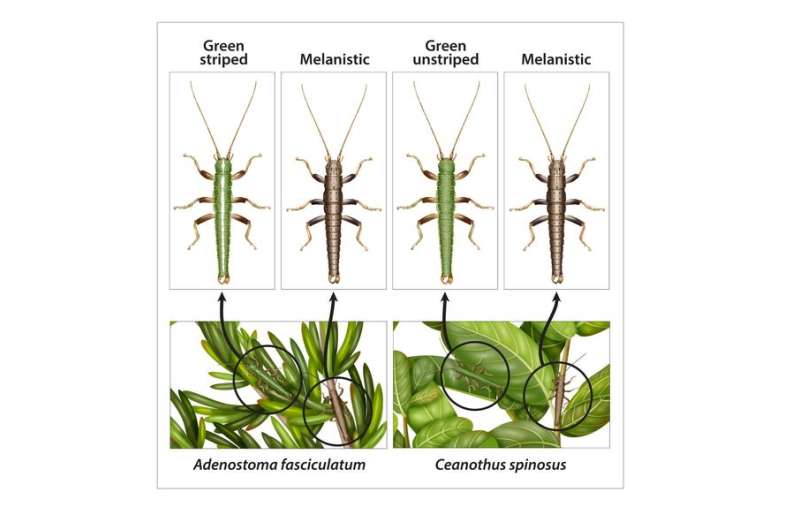Natural selection, key to evolution, also can impede formation of new species

An intriguing study involving walking stick insects led by the University of Sheffield in England and the University of Colorado Boulder shows how natural selection, the engine of evolution, can also impede the formation of new species.
The team studied a plant-eating stick insect species from California called Timema cristinae known for its cryptic camouflage that allows it to hide from hungry birds, said CU-Boulder Assistant Professor Samuel Flaxman. T. cristinae comes in several different types—one is green and blends in with the broad green leaves of a particular shrub species, while a second green variant sports a white, vertical stripe that helps disguise it on a different species of shrub with narrow, needle-like leaves.
While Darwinian natural selection has begun pushing the two green forms of walking sticks down separate paths that could lead to the formation of two new species, the team found that a third melanistic, or brown variation of T. cristinae appears to be thwarting the process, said Flaxman. The brown version is known to successfully camouflage itself among the stems of both shrub species inhabited by its green brethren, he said.
Using field investigations, laboratory genetics, modern genome sequencing and computer simulations, the team concluded the brown version of T. cristinae is shuttling enough genes between the green stick insects living on different shrubs to prevent strong divergent adaptation and speciation. The brown variant of the walking stick species also is favored by natural selection because it has a slight advantage in mate selection and a stronger resistance to fungal infections than its green counterparts.
"This is one of the best demonstrations we know of regarding the counteractive effects of natural selection on speciation," said Flaxman of CU-Boulder's Department of Ecology and Evolutionary Biology, second author on the new study. "We show how the brown population essentially carries genes back and forth between the green populations, acting as a genetic bridge that causes a slowdown in divergence."
A paper on the subject appeared in a recent issue of the journal Current Biology. Other study co-authors were from the University of Sheffield, Royal Holloway University of London, Utah State University, the University of Nevada, Reno and the University of Lausanne in Switzerland.
"This movement of genes between environments slows down the genetic divergence of these stick insect populations, impeding the formation of new species," said Aaron Comeault, a former CU-Boulder graduate student and lead study author who conducted the research while at the University of Sheffield. Comeault is now a postdoctoral researcher at the University of North Carolina at Chapel Hill.
The new results underscore how combining natural history and cutting-edge genetics can help researchers gain a better understanding of how evolution operates in nature. It also shows how natural selection can sometimes promote but other times hinder the formation of new species, according to the research team.
Walking sticks are one of nature's oddest insect groups and range in size from the half-inch long T. cristinae to species in Borneo and Vietnam that are more than a foot long. Most walking sticks rely on plant mimicry to protect them from predators.
Journal information: Current Biology
Provided by University of Colorado at Boulder





















